When it comes to electrical power distribution and protection systems, circuit breakers play a crucial role in ensuring safety and reliability. Among the various types available, vacuum circuit breakers and ordinary circuit breakers stand out as key components with distinct characteristics. Understanding their differences is essential for selecting the appropriate solution for different applications.

-Arc Interruption Medium
Utilizes a vacuum as the medium to interrupt the electrical arc. When the contacts open, the vacuum quickly extinguishes the arc by elongating and cooling it.
-Performance
Offers fast and reliable arc interruption, making it suitable for high-frequency operations and reducing wear on contacts.
-Maintenance
Requires minimal maintenance due to the absence of moving parts in the vacuum interrupters and the longevity of the vacuum itself.
-Applications
Typically used in medium to high voltage applications where rapid and dependable arc extinction is critical, such as in power distribution networks and industrial facilities.
-Arc Interruption Medium
Uses mediums such as air, oil, SF6 gas, or other materials for arc interruption. The effectiveness depends on the specific medium employed.
-Performance
Performance varies based on the chosen medium. Air circuit breakers are common and effective but may not extinguish arcs as swiftly or reliably as vacuum breakers.
-Maintenance
May require more maintenance due to moving parts (e.g., in oil circuit breakers) or potential degradation of interrupting mediums (e.g., air or oil).
-Applications
Used across various voltage levels—low, medium, and high—depending on the specific type and design suited to different operational environments and applications.
3.In summary
vacuum breakers are known for their reliability, efficiency, and reduced maintenance due to their use of vacuum for arc interruption, whereas ordinary circuit breakers vary in performance and maintenance requirements based on the chosen interrupting medium and specific design considerations.